
Strategic sealift ships are part of the United States Military Sealift Command's (MSC) prepositioning program. There are currently 17 ships in the program, strategically positioned around the world to support the Army, Navy, Air Force, Marine Corps and Defense Logistics Agency. Most are named after Medal of Honor recipients from the service they support. The ships are assigned to two Military Prepositioning Ship (MPS) squadrons located in the Indian Ocean at Diego Garcia and in the Western Pacific Ocean at Guam and Saipan.

USNS Lewis and Clark (T-AKE-1) is an American dry cargo ship, the lead ship of her namesake class. It was the second ship of the United States Navy to be named for the explorers Meriwether Lewis and William Clark. The contract to build her was awarded to National Steel and Shipbuilding Company (NASSCO) of San Diego, California, on 18 October 2001 and her keel was laid down on 22 April 2004. She was launched on 21 May 2005, co-sponsored by Jane Lewis Sale Henley and Lisa Clark, descendants of the ship's namesakes. She was delivered to the Navy on 20 June 2006.

The Military Sealift Command (MSC) is an organization that controls the replenishment and military transport ships of the United States Navy. Military Sealift Command has the responsibility for providing sealift and ocean transportation for all US military services as well as for other government agencies. It first came into existence on 9 July 1949 when the Military Sea Transportation Service (MSTS) became solely responsible for the Department of Defense's ocean transport needs. The MSTS was renamed the Military Sealift Command in 1970.
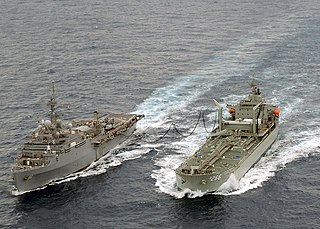
A replenishment oiler or replenishment tanker is a naval auxiliary ship with fuel tanks and dry cargo holds which can supply both fuel and dry stores during underway replenishment (UNREP) at sea. Many countries have used replenishment oilers.

USNS Rappahannock is a Henry J. Kaiser-class underway replenishment oiler operated by the Military Sealift Command to support ships of the United States Navy.

USNS GySgt Fred W. Stockham (T-AK-3017) is a Shughart-class container & roll-on roll-off support vessel in the United States Navy's Military Sealift Command (MSC). The vessel is the second Navy ship named after Marine Gunnery Sergeant Fred W. Stockham (1881–1918), who was posthumously awarded the Medal of Honor during World War I.
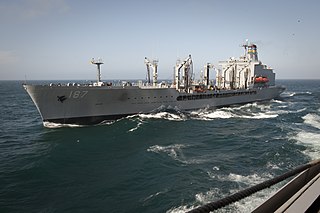
USNS Henry J. Kaiser (T-AO-187) is a United States Navy fleet replenishment oiler and the lead ship of her class. Her mission is to resupply U.S. Navy and allied ships at sea with fuel oil, jet fuel, lubricating oil, potable water, and dry and refrigerated goods, including food and mail.

USNS Maumee (T-AO-149), later T-AOT-149, was a United States Navy Maumee-class oiler, later transport oiler, in non-commissioned service with the Military Sea Transportation Service (MSTS), later Military Sealift Command, from 1956 until probably the mid-1980s.

The Maumee class was a class of four United States Navy fleet oilers in service from the mid-1950s until the mid-1980s. It was the first class of United States Naval Ships.

The fifth USNS Potomac (T-AO-181) was a United States Navy oiler in non-commissioned service with the Military Sea Transportation Service, later Military Sealift Command, from 1976 to 1983.

The SS Chesapeake is a transport oiler that was in service with the United States Navy from 2000 to 2009. She was operated by Military Sealift Command.
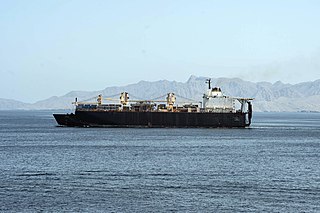
USNS PFC Dewayne T. Williams (T-AK-3009), formerly MV PFC Dewayne T. Williams (AK-3009), is the second ship of the 2nd Lt. John P. Bobo-class cargo ship and one of the maritime prepositioning ships of the US Navy. She is named after Medal of Honor recipient and US Marine Dewayne T. Williams.
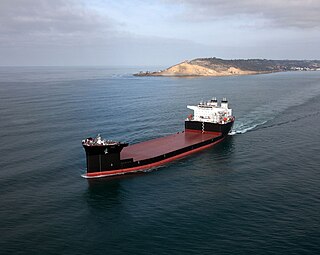
An Expeditionary Transfer Dock (ESD), formerly the Mobile Landing Platform (MLP), is designed to be a semi-submersible, flexible, modular platform providing the US Navy with the capability to perform large-scale logistics movements such as the transfer of vehicles and equipment from sea to shore. These ships significantly reduce the dependency on foreign ports and provide support in the absence of port availability. The class also houses a sub-class variant called the Expeditionary Mobile Base (ESB), formerly the Afloat Forward Staging Base (AFSB).

USNS Montford Point (T-ESD-1),, the lead ship of her class of Expeditionary Transfer Docks (ESD), is a ship named in honor of African American Marine Corps recruits who trained at Montford Point Camp, North Carolina, from 1942 to 1949. After $115 million was allocated for long-lead time material and advanced design efforts, in late 2010 General Dynamics's National Steel and Shipbuilding Company was awarded the contract, worth approximately $500 million, to build the first of three planned vessels.

USNS Paul Buck (T-AOT-1122), a transport oiler ship, was originally constructed in 1985 by American Ship Building Company, Tampa, Florida for Ocean Product Tankers of Houston for a long term charter to the United States Navy and operated by Military Sealift Command. The ship was delivered on 7 July 1985. It is a T-5 Tanker. The ship was named after Merchant Marine Paul Buck, who was awarded the Merchant Marine Distinguished Service Medal. On the morning of February 2, 2024 it was observed being towed through the Brazos Santiago Pass at South Padre Island, presumably for recycling at the Brownsville shipyards.
USNS Richard G. Matthiesen (T-AOT-1124) was one of four tankers, known as T5s, with double hulls ice-strengthened for protection against damage during missions in extreme climates. She was part of Military Sealift Command's Sealift Program, transporting fuel for the Department of Defense. Richard G. Matthiesen had missions including refueling the National Science Foundation in Antarctica and Thule Air Base in Greenland. She was named after Richard G Matthiesen, a Merchant Marine Distinguished Service Medal recipient.

USNS John Glenn (T-ESD-2), is a United States Navy Expeditionary Transfer Dock ship named in honor of John Glenn, a Naval Aviator, retired United States Marine Corps colonel, veteran of World War II and the Korean War, astronaut, and United States senator.
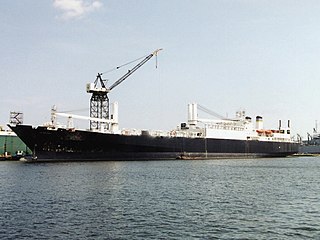
USNS LCPL Roy M. Wheat (T-AK-3016), the only ship of its class, is a cargo ship built in 1987. She became one of the only Soviet ships to enter United States service. The ship is named after Lance Corporal Roy M. Wheat, an American Marine who was awarded the Medal of Honor during Vietnam War.

















